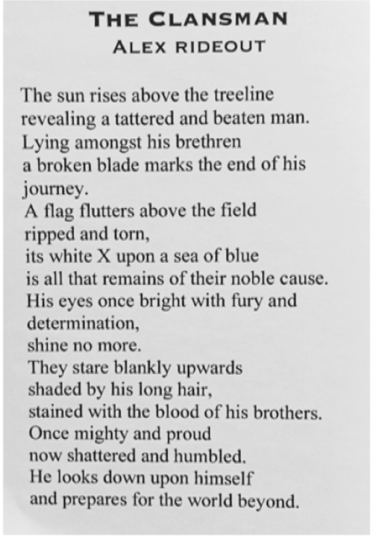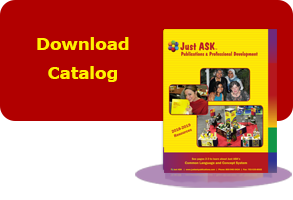
Volume V, Issue III
|
Heather Clayton, the author of Making the Standards Come Alive!, is the principal of Mendon Center Elementary School in Pittsford Central School District, New York. She is also a co-author of Creating a Culture for Learning published by Just ASK. |
It’s Amazing How Authentic Writing
Can Motivate K-12 Writers
“We cannot teach writing well unless we trust that there is a real, human reason to write.”
– Lucy Calkins
“The point of writing is to have something to say and to make a difference in saying it. Rarely, however, is impact the focus in writing instruction in English class.”
– Grant Wiggins
Authenticity in writing is when we ask our students to write in their own voices to audiences outside of the classroom, for a real-world purpose, and on topics of significance. When our students write authentic pieces, they may write for the purposes of informing an audience, persuading readers to agree with their position, debating an issue, or presenting a solution to a problem. Whatever the purpose, authentic writing is in a real world format such as an article, letter, book, interview, or business report. When our students write for real reasons they are empowered, motivated, and inspired to communicate effectively.
To further understand authenticity in writing, it is important to understand what authenticity is not. When we ask our students to assume another’s persona or write from another person’s perspective, while this is still an important learning activity, it is not an authentic task. When writing is decontextualized from real world purposes, when students do not experience choice, and when there is not an audience beyond the classroom, writing becomes a rote exercise versus a meaningful experience that teaches students to value writing. Authenticity connects writers to the outside world, inspires writing for a real audience, and ensures that students’ voices are heard. According to Grant Wiggins, authenticity “stimulates contexts that mirror the workplace and other real-life contexts.” The bottom line is that we need our students to become adults who can write. They need to know how to communicate effectively, ethically, and intelligently.
Ways to Promote Authenticity in Students’ Writing
Focus on the process versus the product.
When promoting authenticity in students’ writing, it is important to place a greater emphasis on the development of students’ ideas relative to the writing versus a focus on layout, grammar, organization and style. A process approach promotes students’ ideas through brainstorming, class discussions, and revision. Students are not asked to merely imitate the structure of a model text, but are empowered to draft ideas and then use models to help them identify ways to convey the message they wish to share.
In a process approach, students should also be engaged in sharing their drafts with classmates for the purposes of reading each other’s work and responding to each other as readers. In a process approach, ideas are the starting point and there is a strong emphasis on the purpose of the writing, the intended audience, and the form. The work is collaborative and students are engaged in a recursive process where their writing is developed through multiple drafts and iterations.
Allow choice.
Our students need to be personally invested in learning for their own purposes. The best way to promote this ownership and inquisitiveness is by involving our students in making choices about what they will learn and how they will communicate their learning with others.
Share students’ writing beyond the classroom.
When students know they are writing for an audience besides their teacher and classmates, the stakes are raised and students are driven to produce their best. Once students know their intended audiences, time should be spent thinking about the different ways to appeal to their audiences. There are number of ways students can do this. For instance, a students’ writing may gain appeal by its stucture, organization, content, craft, evidence, voice, word choice, sentence structure, and layout.
Write for real-world reasons.
Our students inherently have a desire to make an impact on the lives of others. When they recognize the potential power behind their words and see the relevance of their writing, they are inspired to change the world. In the absence of a clear purpose, students’ writing simply becomes an exercise in compliance rather than a vehicle for change.
Seize opportunities to create authentic writing tasks with your students.
Our students become better writers by writing frequently and willingly. In order for this to happen, we need to find ways to motivate our students to write at home and in school not just to fulfill an assignment, but because they crave the opportunity to connect and communicate with others.
One way to increase the frequency of students’ writing is to work with them to design tasks that make them want to share their message and persevere to get it right. Once our students are clear about what they want to work on, we can help them to grow.
When students are concerned with things like required length of a piece, requirements for mechanics, the number of sources required, and whether or not they need to write in complete sentences, we know they are not engaged in authentic writing. Rather than the teacher holding all of the answers, authentic tasks provide students with the chance to write for “experts” and those most personally invested in what they have to say. Students can make their own decisions about their writing and become an authority on their topic.
Embrace students’ questions.
When writing experiences are authentic, our students should be asking questions not for the purpose of identifying a “right” answer, but rather to gain feedback that will help them with future writing decisions. Some questions students may ask when the writing task is authentic are:
- How will my audience respond to my ideas?
- Is my evidence convincing?
- Are the length and form appropriate for my audience?
Authenticity in Action in Our School
At Mendon Center Elementary School in Pittsford, New York, students were intrinsically motivated and highly engaged by the annual task of authoring and illustrating a class book for Scholastic’s annual Kids Are Authors competition. What made this competition so motivating for students was that if the class won, their book would be published by Scholastic and sold at book fairs around the country.
Between the years of 2009 and 2016, there has been one class per school year that entered a book in the nonfiction category. The quality of student work, ingenuity of the topic, and the voices of the students resulted in two grand prize winners and three honorable mentions during the eight years the school participated.
The process of authoring and illustrating a class book was always the same. Students selected a topic based on the interests and knowledge of the class, researched the topic using a myriad of resources, engaged in brainstorming and drafting about that topic, selected a text structure for their writing, then worked collaboratively to revise, edit and publish their writing. At the same time, students made decisions about the medium and style for their art work and the techniques they would use to bring their illustrations to life. Working in conjunction with the art teacher, students created art to accompany each page of their writing. The process of creating a class book required making all decisions collaboratively, following strict timelines, and synthesizing information from a number of resources.
What made these assignments so relevant and authentic for the students was that they were writing for an audience of published authors and illustrators, they were writing about topics that mattered to them, and they were ultimately using art and writing to make a difference in the lives of others.
The Kids Are Authors award-winning books created by Mendon Center students are as follows:
2008-2009
Grand Prize- Published and sold at Scholastic Book Fairs
Rejoice! A Celebration of Life in the Amazon Rain Forest
Written and illustrated by third grade students at Mendon Center Elementary
A book of poetry and non-fiction with colorful collage art informed readers about the variety of life found in the Amazon Rainforest, as well as information about the destruction of the Amazon. The inspiration for the writing came from students’ learning in social studies about the geography of Brazil.

2009-2010
Honorable Mention
Reef: Plunge Into the Living Rainbow
Written and illustrated by third grade students at Mendon Center Elementary
A book of poetry and non-fiction with colored pencil, watercolor and collage art informs readers about the world’s coral reefs and the dangers they face. The inspiration for the writing came when students were engaged in reading about coral reefs and how humans have been destroying the habitats of many sea creatures living in the world’s reefs.
2010-2011
Honorable Mention
Leap!
Written and illustrated by third grade students at Mendon Center Elementary
A book of poetry and non-fiction with magazine photos as the medium for the collage frogs. Readers learn about a variety of frogs, as well as the threats to frogs’ habitats and ways humans can make a difference. The inspiration for the book came when students were engaged in reading non-fiction articles about the habitat destruction of frogs.
2012-2013
Honorable Mention
The Mighty Monarch
Written and illustrated by fourth grade students at Mendon Center Elementary
A book of poetry, non-fiction, and brightly colored collage informs readers about the plight of the monarch and their annual migration. The inspiration for the topic came when students were engaged in reading non-fiction articles about the monarch butterfly.
2014-2015
Grand Prize Winner- Published and sold at Scholastic Book Fairs
Through Jane’s Eyes: Lessons Learned through Dr. Jane Goodall
Written and illustrated by fourth grade students at Mendon Center Elementary
A book of verse and supporting non-fiction combined with colorful collage described lessons learned from the work of Dr. Jane Goodall. The inspiration for the book came from a student in the class who had the privilege of not only hearing Dr. Goodall speak, but meeting her personally as well.

2015-2016
Honorable Mention
Prelude
Written and illustrated by fourth grade students at Mendon Center Elementary
A book of poetry describing significant endings and new beginnings in nature. The inspiration came when the students learned it was the last year of the Kids Are Authors competition. They wanted to write about endings, and through a great deal of brainstorming and discussion, ultimately decided on endings and new beginnings in nature.

“Sandpiper darts across the sand, a treasure trove of ocean’s jewels.”
Unaware of what’s hiding beneath…
K-12 Examples of Authenticity in Action
School Newspaper
Students wrote articles for their high school newspaper that was distributed to all students and faculty. Features in the paper included one-minute interviews of staff members, information about new clubs, reviews of new school performances, and highlights from a mural project completed by students for a local hospital.
Letters to Organizations
A small group of fifth grade students wrote to “Operation Migration” to pose questions they had as a follow-up to a book they read about whooping cranes titled Born to Fly. Students were excited to receive responses from the organization that answered all of their questions.
Persuasive Letters
Middle school students wrote to their principal persuading her to allow them to start a Gay/Straight Alliance Club at their school.
Informational Book
A second grade student, intrigued by a fundraiser for cancer, learned more about the deadly disease. He then authored and illustrated a picture book about cancer that was shared with all of the parents, administration, and teachers in the school.
Proposals
After a unit of study on global issues, fifth grade students wrote proposals to a local grocery store for them to eliminate the use of plastic bags. Students included quotes, a rationale, benefits and opposing viewpoints for making the change to all recyclable bags.
The quote selected by students was “We are living on this planet as if we have another one to go to,” by Terry Swearingen.
Literary Magazine
High school students submited poetry, artwork, articles, and fiction for their school literary magazine available online and in print to all students, faculty, and families.

Thank You Letters
Fifth grade students wrote thank you letters to the local Parent Teacher Association to thank them for the purchase of iPads for the classroom. Students’ letters included evidence of their experiences with the iPads and artifacts illustrating the work they were able to do with the added technology.
Letters to the Editor
High school students wrote letters to the editor of a local newspaper on a myriad of topics.
Speeches
Public-speaking students at a high school authored and recorded original speeches for a Veterans of Foreign Wars national competition entitled “Voice of Democracy.”
Toasts
High school students in public speaking wrote and delivered toasts to a chosen audience outside of the classroom. Some audience members were coaches, parents, and outside mentors.
Public Service Announcements
High school students in a course on Mass Media wrote and produced public service announcements read over the radio.
More Possibilities of K-12 Authentic Writing Products
Teachers should emphasize real-world purposes for writing. When students write authentically, or for real purpose, they are learning how to construct a message, consider their audience, and evaluate their work. Some authentic products students may create include:
- Press releases
- Blogs
- Social media posts
- Postcards
- Photographs and captions
- Charts, diagrams, and graphs
- Emails
- Restaurant Reviews
- Scientific reports
- Field notes
- Movie, book, musical, or play reviews
- Infographics
- Video scripts
- Presentations
- Podcasts
- Brochures
Digital Resources
https://talkswithteachers.com/authenticwriting/
In this article by Brian Sztabnik, “Authentic Writing: What it Means and How to Do It,” nine teachers share their definition of authentic writing and share examples of how they promote it in their secondary classrooms.
https://learning.blogs.nytimes.com/2010/03/22/10-ways-to-promote-writing-for-an-authentic-audience/?_r=0
This link contains 10 ideas for using the feature “Student Opinion” across the curriculum in order to promote writing for an authentic audience. The list includes debating controversies, developing surveys, reviewing arts and entertainment, reflecting on education, and more.
https://writerswhocare.wordpress.com/2014/08/04/igniting-your-childs-passion-and-precision-through-writing-letters-to-editors/
This link shows ways that parents can support their children in writing letters to the editor to advocate positively for things they believe are important.
https://writerswhocare.wordpress.com/2014/05/06/authentic-writing-across-the-curriculum/
This link highlighting Black River Middle School contains a wide range of innovative practices related to authentic writing across the curriculum. On a daily basis they focus on digital literacy and take risks using web based tools and mobile learning devices.
Publishing Opportunities for K-12 Student Writers
https://teacher.scholastic.com/writeit/fiction/publish/competition.htm
This link includes a list of publishing opportunities and writing contests for students.
www.artandwriting.org/
Through the Scholastic Awards, teens in grades 7 through 12 from public, private, or home schools can apply in 29 categories of art and writing for their chance to earn scholarships and have their works exhibited and published.
www.cicadamag.com/
Accepts fiction, creative nonfiction, and poetry from writers between 14 and 23. Artwork and photos are also considered. A “Call for Creative Endeavors” offers a new theme for every issue.
www.teenink.com/Resources/PublishingR.php
Teen Ink publishes a monthly print magazine, daily website, and new book series that are written by teens for teens. Teens may publish essays, short stories, reviews, interviews, poetry, art, and photography.
Student engagement in authentic writing tasks ensures that we are teaching our students to learn the importance of audience, how to determine when a situation requires writing, have a repertoire of strategies for writing, and the ambition to write. One thing our standards aren’t able to do without the work of the teacher is to intrinsically motivate our students to write for a variety of purposes. When students are given the opportunity to write for authentic reasons, they not only learn more about writing in the real world, but they feel empowered to make a difference.
Please include the following citation on all copies:
Clayton, Heather. “It’s Amazing How Authentic Writing Can Motivate K-12 Writers.” Making the Standards Come Alive! Volume V, Issue III 2016. Available at www.justaskpublications.com. Reproduced with permission of Just ASK Publications & Professional Development (Just ASK). ©2016 by Just ASK. All rights reserved.







